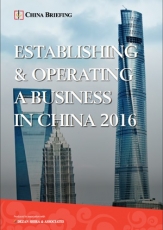An Overview of Transfer Pricing in China
Transfer pricing has fast become one of the standout issues in international taxation. Put simply, the practice concerns the price charged for intercompany transactions between entities in different tax jurisdictions. These transactions can be used to shift funds within a multinational company (MNC), making transfer pricing an effective means to manage a firm’s finances and remit its profits.
As more international companies began to pour into China following its opening up period in the late 1970s, the need for a transfer pricing regime that could effectively collect tax on intercompany transactions and prevent tax base erosion became increasingly apparent. Legislation on transfer pricing in the Middle Kingdom therefore has a relatively long history that stretches back to the early 1990s, but the majority of this has been piecemeal, and it is only in the last ten years that the country began implementing comprehensive regulations. 2016, in particular, has seen the release of new laws that have revamped transfer pricing compliance for MNCs in China.
If implemented early in a Chinese entity’s business life, a transfer pricing system can complement and support an MNC’s business model and commercial objectives, as well as optimize its global effective tax rate. Non-compliance with China’s new transfer pricing laws, however, can result in heavy penalties for an MNC, and subsequently eat into its bottom line.
Recently, Shirley Chu, Transfer Pricing Services Manager at Dezan Shira & Associates provided an in-depth overview of Transfer Pricing in China in the form of a webinar, from the history of Transfer Pricing, to how the system is today regarding both tangibles and intangibles. In addition, she gave some insight into the BEPS Action Plan, how best to stay in compliance with the most up to date regulations, and finally, her experience in the world of Transfer Pricing, including some of the queries which she faces on a daily basis.
The 30 minute webinar concluded with a further 30 minute interactive Q&A session.
Some of the questions included:
Q: I understand that it is important to ensure that the transfer price complies with the arm’s length principle. Do you have any suggestions on how to do this?
A: We would recommend completing a transfer pricing benchmark study. This is helpful for identifying whether or not the profit rate falls within the arm’s length range.
Q: Does transfer pricing regulation differ across provinces in China?
A: Although Chinese transfer pricing legislation is applicable to all provinces across China, the degree of administration may vary from one region to another. If a province is very well developed economically, the tax authorities are often more experienced and hence may pay more attention to transfer pricing compliance.
Q: What are some points to watch out for when preparing TP documentation in China?
A: Transfer Pricing Contemporaneous Documentation is necessary for compliance. All taxpayers whose annual related-party transaction amount exceeds the legislative threshold are required to prepare and submit these documents. Depending on the complexity of the related-party transactions, these usually consist of a 50 to 100 page report containing numerous sub-sections. Often, it is a good idea to consult an experienced firm for advice since they will be more familiar with the work, and will also be able to indicate the potential Transfer Pricing issues in the process.
To watch the webinar, please click here and for further information on the subject of Transfer Pricing, please contact Shirley Chu at shirley.chu@dezshira.com
|
Asia Briefing Ltd. is a subsidiary of Dezan Shira & Associates. Dezan Shira is a specialist foreign direct investment practice, providing corporate establishment, business advisory, tax advisory and compliance, accounting, payroll, due diligence and financial review services to multinationals investing in China, Hong Kong, India, Vietnam, Singapore and the rest of ASEAN. For further information, please email china@dezshira.com or visit www.dezshira.com. Stay up to date with the latest business and investment trends in Asia by subscribing to our complimentary update service featuring news, commentary and regulatory insight. |
![]()
 Revisiting Transfer Pricing in China: a Year of New Regulations
Revisiting Transfer Pricing in China: a Year of New Regulations
In this issue of China Briefing, we provide a guide to navigating China’s latest regulations, highlighting the main issues that exist for foreign companies, and explaining the various transfer pricing methods and processes that exist. 2016 has seen the release of new laws that have revamped transfer pricing compliance for MNCs in China. If implemented early in a Chinese entity’s business life, a transfer pricing system can complement and support an MNC’s business model and commercial objectives, as well as optimize its global effective tax rate.
 Establishing & Operating a Business in China 2016
Establishing & Operating a Business in China 2016
Establishing & Operating a Business in China 2016, produced in collaboration with the experts at Dezan Shira & Associates, explores the establishment procedures and related considerations of the Representative Office (RO), and two types of Limited Liability Companies: the Wholly Foreign-owned Enterprise (WFOE) and the Sino-foreign Joint Venture (JV). The guide also includes issues specific to Hong Kong and Singapore holding companies, and details how foreign investors can close a foreign-invested enterprise smoothly in China.
 An Introduction to Doing Business in China 2016
An Introduction to Doing Business in China 2016
Doing Business in China 2016 is designed to introduce the fundamentals of investing in China. Compiled by the professionals at Dezan Shira & Associates in June 2016, this comprehensive guide is ideal not only for businesses looking to enter the Chinese market, but also for companies who already have a presence here and want to keep up-to-date with the most recent and relevant policy changes
- Previous Article Evaluating China’s VAT Reform – New Issue of China Briefing Magazine
- Next Article Electronic Chops in China: Unauthorized Use and Legal Risk Management









